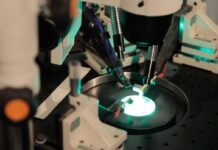
Global semiconductor developer BluGlass has teamed up with Macquarie University and defence company Aurizn to develop a laser technology for subsurface water temperature and depth measurement.
The collaboration, led by Macquarie University, will use BluGlass’ gallium nitride (GaN) lasers to power a new blue ocean LiDAR (Light Detection and Ranging) system, designed to improve maritime situational awareness and environmental monitoring.
The project, supported by an AUD 182,000 Australia’s Economic Accelerator (AEA) Seed Grant, aims to enhance current methods, which rely on satellites and marine buoys, by introducing high-precision underwater detection systems.
The new technology will have applications ranging from maritime defence to improving climate models and coral reef health assessments.
Blue ocean LiDAR could also aid in detecting underwater objects and offer more accurate predictions of coral bleaching events, the ASX-listed company said in a media release.
Traditional invisible infrared (IR) lasers, commonly used in space communications and fibre-optics, are largely ineffective underwater due to absorption by water.
This project will instead utilise BluGlass’ high-power GaN lasers, which operate at shorter wavelengths between violet and green, making them more suitable for underwater applications.
Jim Haden, BluGlass CEO, expressed enthusiasm for the collaboration, stating, “As one of only a few GaN laser manufacturers globally, BluGlass is excited to partner with Macquarie University and Aurizn to co-develop this next-generation LiDAR technology.”
“We are excited to see our BluGlass GaN lasers deployed in underwater environments for field testing and validation.”
Professor Sakkie Pretorius, deputy vice-chancellor (Research) at Macquarie University, also highlighted the project’s significance.
“This collaborative project with BluGlass and Aurizn perfectly aligns with Macquarie University’s world-class expertise in laser technology. In developing blue ocean LiDAR technology, we’re helping create solutions that address real-world challenges, from improving maritime defence to enhancing our understanding of coral reef health and climate change.”
Dr Ondrej Kitzler, project lead and Research Fellow at Macquarie University’s Photonics Research Centre, added, “Invisible infrared lasers are widely used in terrestrial remote sensing and communications, but their wavelengths are largely absorbed by water. To use lasers for remote sensing and communicating underwater, visible lasers at shorter wavelengths between the violet and green spectrum are needed. The unique semiconductor lasers developed by BluGlass operate between 420 to 520 nanometres, making them ideal for these demanding applications.”
Aurizn’s Chief Scientist, Dr Peter Amerl, reinforced the project’s defence applications, stating: “This project builds on the development of remote electro-optical sensing systems that Aurizn has spearheaded in partnership with Defence. We look forward to applying our expertise to help guide the project to ensure suitable outcomes for both Defence and National Security use.”
Upon completion of the development phase, the partners intend to explore opportunities to commercialise and manufacture the blue ocean LiDAR system.















